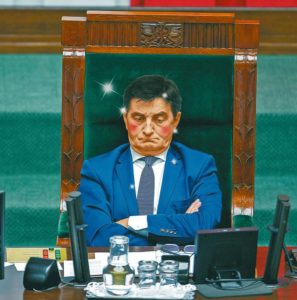
In December 2016, Super Express, a popular Polish tabloid newspaper, published a story in which it accused Mr Marek Kuchciński – politician and current Speaker of the lower house of the Polish Parliament (Sejm) – of lying. The text was accompanied by the photograph presented below.

Mr Kuchciński’s photograph was obviously edited. Blush was added to his cheeks (to emphasise dishonesty), along with several sparkling highlights.
The Speaker’s office issued a letter demanding that a correction of the article be printed. Polish press law (Act of 26 January 1984) provides a procedure for doing so whenever a newspaper publishes false information. Curiously, however, Mr Kuchciński’s request was not only related to the allegedly false information in the article as such. He also demanded a correction of his photograph.
This is likely to be the first case of its kind in Poland. It certainly is something that Polish press law is not familiar with. While the scope of the law does not exclude photographs or other information published in graphical form, the provisions on corrections clearly refer only to corrections made in written form or, in the context of radio and television, audio and/or video.
If we read the law in the context of correcting photographs, some interesting problems emerge:
- According to press law, a correction may only be related to an “inaccurate or false message included in a press publication”. Non-factual statements (opinions) may not be corrected – which is reasonable, as opinions may not be considered true or false. The photo in question is “false” in that it does not present Mr Kuchciński the way he actually looks. However, since it is obvious that the photo was manipulated, can readers realistically be deceived by it? Shouldn’t this photo – especially in the context of the article it accompanied – be considered as a form of expressing an opinion, rather than a fact?
- The law requires the contents of the correction to be prepared by the applicant. There is a limit to the size of the correction. Press law reads: “The text of the correction may not exceed twice the size of the fragment of the press publication which the correction is related to”. For radio or TV, the limit is twice the length of the relevant airtime. The law refers to the “text of the correction” – can there be such “text” in relation to a photograph? What form should it have? Even if we prepare a text describing the irregularities of a photo, how can we measure the size of such correction?
- The limit mentioned above does not relate to the size of the full publication, but rather to the size of false information. The rule is interpreted in such way that, for example, if there was a false sentence in an article, the correction may not be longer than twice the length of that sentence. It is impossible to apply this rule to the case of Mr Kuchciński’s photo, as it would mean that – for example – the size of the correction regarding his blushing cheeks may not be larger than twice the size of the blush. Clearly, this application does not make sense.
- In practice, Mr Kuchciński demanded that the same photograph be published again, but this time without any changes. However, press law requires the correction to be prepared “in the Polish language or in the language in which the press publication being corrected was published”. Of course, photographs do not have a language. Therefore, the question is whether a correction in the form of a photograph can possibly meet the Polish language requirement?
It is clear that Polish press law was not designed with photograph corrections in mind. While the case could be seen as frivolous given that Mr Kuchciński’s demand was ridiculed in the media, a similar situation may arise that could pose a legitimate problem. With the abundance of photo manipulation in the media and phenomena such as the recent eruption of “fake news“, there may be legitimate cases where a photograph (or a video) is altered to convey a false message, with the intention of deceiving readers. In such cases, the Polish regulation on corrections seems inadequate. While other legal means exist to deal with such problems, the specialised tool to combat the spread of false information seems ill-equipped for the task.
It is not clear what lies ahead for Mr Kuchciński’s photo case. If Super Express refuses to publish the correction, it may ultimately face legal action. Meanwhile, when asked how the request will be responded to, the editor in chief of the newspaper stated, “I have no idea what to do about the correction – I still haven’t finished laughing”.









